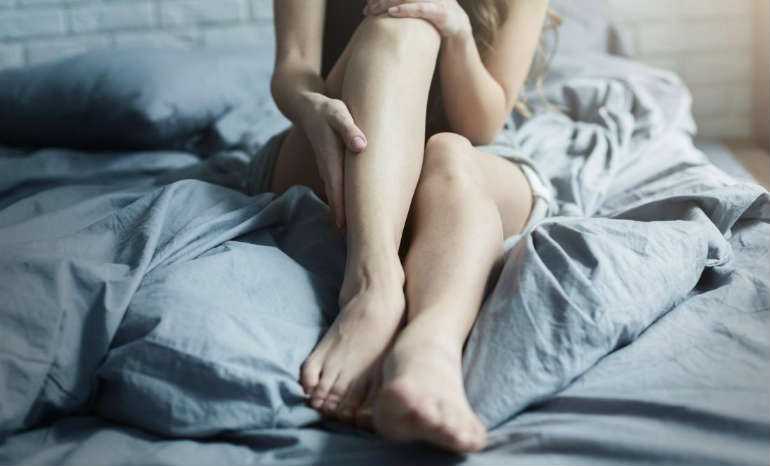Weighted Blankets for Restless Leg Syndrome

- https://www.ninds.nih.gov/Disorders/All-Disorders/Restless-Legs-Syndrome-Information-Page
- https://pediatrics.aappublications.org/content/120/2/253.short
- https://www.mayoclinic.org/diseases-conditions/restless-legs-syndrome/symptoms-causes/syc-20377168
- https://www.nhs.uk/conditions/iron-deficiency-anaemia/
- http://www.sleepfoundation.org/alert/people-parkinsons-disease-more-likely-have-leg-restlessness-restless-legs-syndrome
- https://www.medscape.com/answers/1188327-25545/what-are-the-common-secondary-causes-of-restless-legs-syndrome-rls
- https://www.ninds.nih.gov/Disorders/Patient-Caregiver-Education/Fact-Sheets/Restless-Legs-Syndrome-Fact-Sheet
- https://blogs.iu.edu/healthmed/2018/06/17/science-says-weighted-blankets-could-be-the-solution-to-americas-sleep-problems/
- https://www.thecut.com/2015/06/nightmare-of-restless-leg-syndrome.html
- https://onlinelibrary.wiley.com/doi/10.1111/jsr.13743
While this disorder is more common in women than in men, it can affect anyone across all gender, race, ethnic, and socioeconomic barriers. Symptoms of RLS can begin at any age, but usually worsen as a person gets older.
| Recommended Weighted Blankets | Our Rating | ||
|---|---|---|---|
| Baloo Weighted Blanket | Best Overall | Check price | |
| LUXOME Weighted Blanket | Best Premium | Check price | |
| BABO Cooling Weighted Blanket | Best Cooling | Check price | |
| Gravity Blankets | TIME Magazine’s Best Inventions of 2018 | Check price |
Symptoms
First of all, before coming to conclusions RLS requires a medical diagnosis by a doctor, who will consider symptoms such as an overwhelming urge to move the legs - especially at night or during periods of rest and inactivity - and persistent tingling in the legs and feet, or other unpleasant sensations.
A doctor may use a needle electromyography test and other nerve tests when testing for restless legs syndrome.
The symptoms of Restless Legs Syndrome can change on a daily basis, and may differ from person to person. They may disappear completely for some time, then return.
It has been observed that the symptoms get worse in the evening and at night, when most people are sitting or lying down.
What Causes Restless Legs Syndrome?
RLS can also present itself during pregnancy, especially during the third trimester (it usually disappear within a month after delivery), and can also result from other hormone imbalances.
Some studies suggest that RLS may be related to low dopamine levels, which is a chemical that aids in muscle movement.
RLS is often linked to pre-existing conditions such as Parkinson’s Disease, iron deficiency, diabetes, and neuropathy.
Certain medications, such as some antidepressants, antipsychotic drugs, antihistamines, anti-nausea, and even some cold medicines, can all have the potential side effect of Restless Leg Syndrome.
Cure for RLS
There is no sure cure for Restless Leg Syndrome, instead, care is focusing more on relieving symptoms.
Many individuals suffering from RLS suffer from insomnia. Since RLS symptoms are usually the most severe at night or during periods of rest, this condition often prevents individuals from being able to fall asleep quickly.
The painful and persistent tingling and itching sensations that accompany RLS often present themselves during sleep, as well, causing frequent disturbances in the sleep/wake cycle.
Lack of sleep can have other serious consequences on physical health, such as obesity, impaired judgment, hypertension, stroke, and cardiac disease. Unhealthy sleep disturbances as a result of RLS symptoms can be further detrimental to a person’s health.
Managing RLS

Cases of Restless Legs Syndrome that are not linked to more serious or underlying health conditions may not require further treatment in mild forms.
Some natural ways to treat Restless Leg Syndrome include massages, iron supplements, and relaxation techniques before bedtime. The symptoms of RLS can also affect other parts of the body such as the torso and the arms. Weighted blankets and DTP can help relax all the muscles in the body, making it easier to wind down when it’s time before bed.
Using other massage and relaxation techniques before wrapping up may help. Daily yoga exercises can help manage RLS discomfort. Certain yoga poses and stretching before bed can have positive results.
Try using breathing techniques along with contracting and releasing the leg muscles as well. Contract the leg muscles while inhaling and exhaling while relaxing the muscles.
Also, if symptoms of RLS flare up when lying down, it can help to get out of the bed and move around or stretch. This can help alleviate symptoms, but it can also trick the mind into not associating the bed with discomfort or insomnia.
Using one of the best weighted blankets at night, however, can still enhance the benefits of these natural techniques and promote a more restful night of sleep.
In general, lifestyle changes may help people with mild to moderate symptoms, such as:
- Regular exercise
- Better sleep habits
- Stop smoking
There are of course drugs that are often used to manage RLS and ease symptoms. These are usually anti-seizure drugs, Dopaminergic agents and opioids
Secondary RLS
The difference with secondary RLS is that the symptoms usually subside when the underlying condition is treated. Primary RLS symptoms, on the other hand, tend to get worse over time.
Even though the symptoms may be temporary with secondary RLS, Deep Touch Pressure can still greatly benefit those suffering from RLS.
Weighted blankets, for example, can still help aid secondary RLS management through tactile sensory input, serotonin, and melatonin production.
Read more about weighted blanket benefits for RLS in the next section.
How Can a Weighted Blanket Help RLS?
Weighted blankets consist of square pockets filled with weights that are quilted together to make a heavy blanket.
Weighted items such as poly-pellets or other beads are often used as filler in the pockets. The quilted design helps to evenly distribute the weight throughout the blanket.
The benefits of a weighted blanket for those who suffer from RLS are two-fold: a weighted blanket can calm and soothe the muscles and nerves in the leg, as well as soothe and calm the mind.
Furthermore, weighted blankets provide input for the tactile sensory system, which relies on touch. The tactile sensory system receives and processes messages absorbed through the sense of touch.
RLS is a neurologically based disorder. That means the messages received by the senses and carried by the nerves to the brain play a part in the manifestations of RLS - but they may play a role in the treatment of RLS, as well.
As mentioned earlier at possible causes, dopamine could be one of the factors that needs to be taken into account.
Weighted blankets, through the science of DTP and tactile input can stimulate the production of “the happy hormones” serotonin and dopamine. These chemicals promote a sense of calm and overall well-being.
As a result of these hormones’ productions, the body can also become more calm. Physical symptoms of RLS are often decreased as serotonin levels increase. Another benefit of serotonin is that it produces melatonin - “the sleep hormone”.
More serotonin means more melatonin, which means better sleep!
Depression
Prolonged experience of RLS symptoms, especially when they have been disrupting sleep and causing pain or discomfort for years, can lead to depression. Moderate to severe RLS almost always robs individuals of sleep.
This can lead to a plethora of health issues, including depression. Lack of sleep is often linked to anxiety or depression.
Weighted blankets can improve the symptoms of RLS while also making it easier to fall asleep. Improved sleep patterns can also help ward off depression before it rears its ugly head.
Conclusion
Restless Leg Syndrome is a common condition that can vary in levels of severity. Moderate to severe RLS can have detrimental effects on health and often causes insomnia.
A variety of natural methods can help with the management of RLS, especially weighted blankets.
The science of Deep Touch Pressure makes weighted blankets an excellent option for treating the muscle and nerve discomfort caused by RLS, as well as insomnia.
